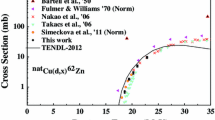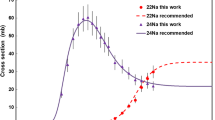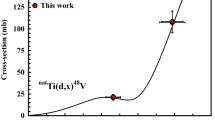Abstract
In the frame of a systematic study of activation cross sections of deuteron induced reactions, experimental cross section data were measured on Mn (monoisotopic 55Mn) up to 50 MeV for the formation of 56,54,52Mn, 48V and 51Cr by using stacked-foil activation method and high resolution gamma spectrometry. The experimental data are compared with the earlier published data and with the results predicted by the ALICE-IPPE-D and EMPIRE-II-D theoretical codes, and with the data taken from the on-line TENDL-2017 library.
Similar content being viewed by others
Introduction
Activation cross sections of residual nuclides with deuteron are basic data for applications around modern accelerators e.g. in radiation dose estimations for accelerator and target technology, in medical isotope production, in radio-analytical studies for biomedical research and wear control by thin layer activation technique. The status of experimental database for deuteron induced reactions—opposite to protons- is very poor (especially above 15 MeV), no systematical study has been performed earlier and in the published data (except for a few well measured monitor and medically important reactions) show large discrepancies. We hence performed a systematic experimental study of deuteron induced activation cross sections for around 60 elements during the last decades. A systematic comparison with the theoretical models allows conclusions on the predictivity of the different nuclear reaction model codes (ALICE-IPPE, EMPIRE-II, GNASH, TALYS, PHITS).
Manganese metal is an important component of different alloys used in nuclear technology. The experimental activation cross sections data are important for further development of the theoretical codes for deuteron induced nuclear reactions and for optimization of production routes of some medically relevant radionuclides 52gMn [1] and 51Cr [2].
In spite of the scientific and practical interest, only a couple of authors published cross section data on deuteron induced reactions on Mn. Gilly et al. [3], Baron et al. [4] and Coetzee et al. [5] studied the excitation functions of (d, p) reactions up to 12 MeV. Ochiai et al. [6] measured the cross section of the activation product 54Mn at 39.5 MeV and our group investigated the excitation functions for the production of 56,54,52Mn and 51Cr (Ditroi et al. [7]).
Thick target yields data were reported by Bondarenko and Rudenko [8] using 3 MeV deuterons for activation analysis; Vakilova et al. [9] also investigated the production yield for the determination of trace elements by deuteron activation. Dmitriev et al. [10] made a systematic study of thick target yields at 22 MeV deuterons induced reactions on a large number of target elements.
In the present work we determined the production cross-section of 56,54,52Mn, 48V and 51Cr in the 50 MeV deuteron induced activation of 55Mn. This has been done to extend the 55Mn(d, x) reaction cross-sections up to the deuteron energy of 50 MeV.
Experiment and data evaluation
For the cross section determination an activation method, based on stacked foil irradiation followed by γ-ray spectrometry was used. The stack consisted of a sequence of 7 blocks of Hf (10.54 μm), Al (49.54 μm), Al (49.54 μm), Pt (19.29 μm), Al (49.54 μm), Al (49.54 μm), NiMnCu alloy (24.73 μm), Al (49.54 μm), Al (49.54 μm) foils, repeated seven times and bombarded for 3600 s with a 50 MeV proton beam of 100 nA at Louvain la Neuve cyclotron laboratory. The activity produced in the targets and monitor foils was measured non-destructively (without chemical separation) using a high resolution HPGe gamma-ray spectrometer. The evaluation of the gamma-ray spectra was made by both a commercial and an interactive peak fitting codes.
The decay data were taken from the online database NuDat2 [11] and the Q-values of the contributing reactions from the Q-value calculator [12].
The effective beam energy and the energy scale were determined initially by a stopping calculation and finally corrected on the basis of the excitation functions of the 24Al(p, x)22,24Na monitor reactions simultaneously re-measured over the whole energy range. For estimation of the uncertainty of the median energy in the target samples and in the monitor foils, the cumulative errors influencing the calculated energy (incident proton energy, thickness of the foils, beam straggling) have been taken into account. The beam intensity was obtained on the basis of the excitation functions of the monitor reactions. The uncertainty on each cross-section was estimated by taking the square root of the sum in quadrature of all individual contributions.
The important experimental parameters and the methods of data evaluation for this work are summarized in Table 1. The targets consisted of a Ni–Mn–Cu alloy with known composition (Ni: 2%—Mn: 12%—Cu: 86%) and in principle the investigated products (56,54,52Mn, 48V and 51Cr) could, apart from reactions on 55Mn, also be produced by nuclear reactions on the other two alloy components. The cross sections for activation of these product nuclides on Ni and Cu by deuterons were, however, investigated by us earlier [13, 14]. Based on the published results and on the target composition we only had to introduce negligible corrections to the cross sections derived in the present study. The decay data used are presented in Table 2.
Theoretical calculations od cross sections
The results for model calculations, performed up to 50 MeV, are taken from our previous study [7]. The updated ALICE-IPPE-D [24] and EMPIRE-D [25] codes were used to compare with the experimental results. As described in detail in Tarkanyi et al. [27] and Hermanne et al. [28] these improved codes were developed to achieve a better description of deuteron induced reactions. In the original versions of the programs a simulation of direct (d, p) and (d, t) phenomena is applied through an energy dependent enhancement factor for the transitions in question. The selection of parameters is given in [29]. The theoretical data from the recently updated TENDL-2017 [30] library (based on the modified TALYS 1.9 code [31]) was also used for a comparison.
Cross sections
The cross sections for reactions studied are shown in Figs. 1, 2, 3, 4 and 5 and the numerical values are collected in Table 3.
55Mn(d, p)56Mn reaction
The excitation function for 56Mn (T1/2 = 2.5789 h) radioisotope, formed by the 55Mn(d, p)56Mn reaction, is shown in Fig. 1, together with the previous experimental data and theoretical calculations. The agreement of our new data with the literature values in the studied energy range is acceptable. When comparing all experimental data with the results of theoretical calculations the agreement is good in case of ALICE-IPPE-D and EMPIRE-D up to 15 MeV but above this energy the theoretical values decrease faster. A significant difference in the magnitude of the cross sections is observed for TENDL-2017.
55Mn(d, x)54Mn reaction
For production of 54Mn (T1/2 = 312.20 days) the previously published single data point of Ochiai et al. [6] and our earlier data [7] are in good agreement with the new results (Fig. 2). The theoretical descriptions are acceptable regarding the shape, but the overestimation is significant especially around the maximum. The best agreement can be observed with the EMPIRE-D up to 25 MeV and above 40 MeV. The maximum energy of the excitation function curve is estimated almost correctly by the EMPIRE-D.
55Mn(d, x)52Mn reaction
The long-lived radionuclide 52Mn (T1/2 = 5.591 days for the ground state) is produced via the reaction 55Mn(d, p4n) with high threshold and through the decay of shorter-lived parent 52Fe (T1/2 = 8.725 h, Q = 37.9 MeV). We could not identify the gamma-lines of 52Fe in our spectra (Eγ = 168.688 keV, Iγ = 99.2%), but the presented cross section values are cumulative and include also the small contribution by isomeric decay (1.75%) of the short-lived metastable state 52mMn. The data of the different theoretical codes show large differences (Fig. 3), ALICE and above 45 MeV and EMPIRE underestimates in the same energy range.
55Mn(d, x)51Cr reaction
The practical threshold around 20 MeV indicates that the main contributing process for production of 51Cr (27.701 days) is the 55Mn(d, α2n) reaction and that contributions of the high threshold, short half-life, 51Fe–51Mn decay chain is negligible. The new data are in good agreement with our previous lower energy data (Fig. 4). There are large disagreements between the different theoretical predictions and consequently with the experimental data. Only ALICE-D produces partial agreement up to 35 MeV.
55Mn(d, x)48V reaction
We obtained only a few cross section data points for production of 48V (T1/2 = 15.9735 days) through clustered emission near the reaction threshold (Fig. 5). The data points could only be measured with relatively large errors. Comparable theoretical predictions could only be found in the TENDL-2017 on-line library and this calculation strongly underestimates the experimental data.
Thick target yields
Thick target yields (integral yields for a given bombarding energy down to the threshold of the reaction) were calculated for 56,54,52Mn and 51Cr from fitted curves to our experimental cross section data The results for physical yields [22, 23] are presented in Fig. 6.
Summary
Excitation functions for the production of 56,54,52Mn, 51Cr and 48V by deuteron irradiation of monoisotopic manganese targets were determined. Out of the investigated reactions no earlier data were available for 48V while for 54,52Mn and 51Cr practically only our recently measured and published experimental data exists showing good agreement in the overlapping energy range. For the production of 56Mn, more earlier experimental data are available, which show only moderate agreement with our new results. Comparison of our experimental results with the predictions of theoretical codes show rather variable agreement. The disagreement is very significant in some cases.
Concerning the possible applications, manganese is a significant alloying element for different iron containing end even iron-free alloys. Knowledge of the deuteron-induced activation cross sections up to higher energies is important for improvement of recommended data for different activation data libraries: for Fusion Evaluated Nuclear Library [32], for JANIS Book of deuteron-induced cross-sections [33, 34] and for European Activation File [35] for calculation of induced activity for the high intensity deuteron accelerators (IFMIF [34, 36] Spiral [37] and other accelerator driven neutron sources [38]).
References
Coenen HH, Buchholz M, Spahn I (2014) Production of 52gMn and 147Gd for the development of multi-modal imaging probes. Nucl Med Biol 41(7):646. https://doi.org/10.1016/j.nucmedbio.2014.05.076
Rand ML, Packham MA, Mustard JF (1983) Survival of density subpopulations of rabbit platelets: use of 51Cr-or 111In-labeled platelets to measure survival of least dense and most dense platelets concurrently. Blood 61(2):362–367
Gilly LJ, Henriet GA, Alves MP, Capron PC (1963) Absolute cross sections and excitation functions for (d, p) and (d, 2n) reactions on 55Mn, 63Cu, 65Cu, 66Zn, and 68Zn between 3 and 11.6 MeV. Phys Rev 131(4):1727–1731. https://doi.org/10.1103/physrev.131.1727
Baron N, Cohen BL (1963) Activation cross-section survey of deuteron-induced reactions. Phys Rev 129(6):2636–2642
Coetzee Paul P, Peisach M (1972) Activation cross sections for deuteron-induced reactions on some elements of the first transition series, up to 5.5 MeV. Radiochim Acta. https://doi.org/10.1524/ract.1972.17.1.1
Ochiai K, Nakao M, Kubota N, Sato S, Yamauchi M, Ishioka NH, Nishitani T, Konno C (2007) Deuteron induced activation cross section measurement for IFMIF. In: Conf. on Nucl. Data for Sci. And Technology, Nice, France, 2007. p 1011
Ditrói F, Tárkányi F, Takács S, Hermanne A, Yamazaki H, Baba M, Mohammadi A, Ignatyuk AV (2011) Activation cross-sections of deuteron induced nuclear reactions on manganese up to 40 MeV. Nucl Instrum Methods Phys Res Sect B 269(17):1878–1883. https://doi.org/10.1016/j.nimb.2011.05.020
Bondarenko YI, Rudenko VS (1982) Use of deuterons with 3-Mev energy in activation-analysis. At Energy (NY, NY, US) 52(3):193–194. https://doi.org/10.1007/Bf01126994
Vakilova G, Vasidov A, Mukhammedov S, Pardaev E, Rakhmanov A, Saidmuradov Z (1983) Sensitivity of the determination of some elements with Z less-than-or-equal-to 42 by a deuteron activational method in a cyclotron. At Energy (NY, NY, US) 55(3):598–602. https://doi.org/10.1007/Bf01127995
Dmitriev PP, Krasnov NN, Molin GA (1982) Radioactive nuclide yields for thick target at 22 MeV deuterons energy. Yadernie Konstanti 34(4):38
NuDat2 database (2.6) (2014) National Nuclear Data Center, Brookhaven National Laboratory. http://www.nndc.bnl.gov/nudat2/
Q-value calculator (2003) NNDC, Brookhaven National Laboratory. http://www.nndc.bnl.gov/qcalc
Takács S, Tárkányi F, Király B, Hermanne A, Sonck M (2007) Evaluated activation cross sections of longer-lived radionuclides produced by deuteron induced reactions on natural nickel. Nucl Instrum Methods Phys Res Sect B 260(2):495–507. https://doi.org/10.1016/j.nimb.2006.11.136
Takács S, Tárkányi F, Király B, Hermanne A, Sonck M (2006) Evaluated activation cross sections of longer-lived radionuclides produced by deuteron-induced reactions on natural copper. Nucl Instrum Methods Phys Res Sect B 251(1):56–65. https://doi.org/10.1016/j.nimb.2006.06.007
Canberra (2000) http://www.canberra.com/products/radiochemistry_lab/genie-2000-software.asp. 2013
Székely G (1985) Fgm—a flexible gamma-spectrum analysis program for a small computer. Comput Phys Commun 34(3):313–324. https://doi.org/10.1016/0010-4655(85)90008-6
Tárkányi F, Szelecsényi F, Takács S (1991) Determination of effective bombarding energies and fluxes using improved stacked-foil technique. Acta Radiol Suppl 376:72
Kinsey RR, Dunford CL, Tuli JK, Burrows TW (1997) in Capture gamma-ray spectroscopy and related topics, vol 2. (NUDAT 2.6 http://www.nndc.bnl.gov/nudat2/), vol 2. Springer Hungarica Ltd, Budapest
Andersen HH, Ziegler JF (1977) Hydrogen stopping powers and ranges in all elements. The stopping and ranges of ions in matter, vol 3. The Stopping and ranges of ions in matter, vol 3. Pergamon Press, New York
Tárkányi F, Takács S, Gul K, Hermanne A, Mustafa MG, Nortier M, Oblozinsky P, Qaim SM, Scholten B, Shubin YN, Youxiang Z (2001) Beam monitor reactions (Chapter 4). Charged particle cross-section database for medical radioisotope production: diagnostic radioisotopes and monitor reactions. TECDOC 1211, vol 1211. IAEA
International-Bureau-of-Weights-and-Measures (1993) Guide to the expression of uncertainty in measurement, 1st edn. International Organization for Standardization, Genève
Bonardi M (1987) The contribution to nuclear data for biomedical radioisotope production from the Milan cyclotron facility. In: Paper presented at the consultants meeting on data requirements for medical radioisotope production, Tokyo, Japan
Otuka N, Takács S (2015) Definitions of radioisotope thick target yields. Radiochim Acta 103(1):1–6. https://doi.org/10.1515/ract-2013-2234
Dityuk AI, Konobeyev AY, Lunev VP, Shubin YN (1998) New version of the advanced computer code ALICE-IPPE. INDC (CCP)-410. IAEA, Vienna
Herman M, Capote R, Carlson BV, Oblozinsky P, Sin M, Trkov A, Wienke H, Zerkin V (2007) EMPIRE: nuclear reaction model code system for data evaluation. Nucl Data Sheets 108(12):2655–2715. https://doi.org/10.1016/j.nds.2007.11.003
Koning AJ, Rochman D, Kopecky J, Sublet JC, Bauge E, Hilaire S, Romain P, Morillon B, Duarte H, van der Marck S, Pomp S, Sjostrand H, Forrest R, Henriksson H, Cabellos O, S. G, Leppanen J, Leeb H, Plompen A, Mills R (2015) TENDL-2015: TALYS-based evaluated nuclear data library. https://tendl.web.psi.ch/tendl_2015/tendl2015.html
Tárkányi F, Hermanne A, Takács S, Hilgers K, Kovalev SF, Ignatyuk AV, Qaim SM (2007) Study of the 192Os(d, 2n) reaction for, production of the therapeutic radionuclide 192Ir in no-carrier added form. Appl Radiat Isot 65(11):1215–1220. https://doi.org/10.1016/j.apradiso.2007.06.007
Hermanne A, Tárkányi F, Takács S, Ditrói F, Baba M, Ohtshuki T, Spahn I, Ignatyuk AV (2009) Excitation functions for production of medically relevant radioisotopes in deuteron irradiations of Pr and Tm targets. Nucl Instrum Methods Phys Res Sect B 267(5):727–736. https://doi.org/10.1016/j.nimb.2008.12.017
Belgya T, Bersillon O, Capote R, Fukahori T, Zhigang G, Goriely S, Herman M, Ignatyuk AV, Kailas S, Koning A, Oblozinsky P, Plujko V, Young P (2005) Handbook for calculations of nuclear reaction data: Reference Input Parameter Library. http://www-nds.iaea.org/RIPL-2/. IAEA, Vienna
Koning AJ, Rochman D, Sublet JC (2017) TENDL-2017 TALYS-based evaluated nuclear data library. https://tendl.web.psi.ch/tendl_2017/tendl2017.html. 2018
Koning AJ, Hilaire S, Duijvestijn MC (2007) TALYS-1.0. In: Paper presented at the international conference on nuclear data for science and technology, Nice, France
IAEA (2011) Fusion Evaluated Nuclear Data Library FENDL 3.0. IAEA. http://www-nds.iaea.org/fendl3/. 2013
Soppera N, Dupont E, Bossant M, Fleming M (2018) JANIS book of deuteron-induced cross-sections comparison of evaluated and experimental data from ENDF/B-VIII.0, TENDL-2017 and EXFOR. http://www.oecd-nea.org/janis/book/book-deuteron-2018-05.pdf. JANIS Books. OECD NEA Data Bank
Blideanu V, García M, Joyer P, López D, Mayoral A, Ogando F, Ortíz F, Sanz J, Sauvan P (2011) Deuteron cross section evaluation for safety and radioprotection calculations of IFMIF/EVEDA accelerator prototype. J Nucl Mater 417(1):1271–1274. https://doi.org/10.1016/j.jnucmat.2010.12.270
Forrest RA, Kopecky J (2009) The activation system EASY-2007. J Nucl Mater 386:878–881. https://doi.org/10.1016/j.jnucmat.2008.12.194
IFMIF (1996) IFMIF conceptual design activity, final report. IFMIF. http://www.frascati.enea.it/cda/FinalReport/. 2018
GANIL (2005) Origin of the SPIRAL2 project. GANIL. http://pro.ganil-spiral2.eu/spiral2/origin-of-spiral2
Nagai Y, Hashimoto K, Hatsukawa Y, Saeki H, Motoishi S, Sato N, Kawabata M, Harada H, Kin T, Tsukada K, Sato TK, Minato F, Iwamoto O, Iwamoto N, Seki Y, Yokoyama K, Shiina T, Ohta A, Takeuchi N, Kawauchi Y, Sato N, Yamabayashi H, Adachi Y, Kikuchi Y, Mitsumoto T, Igarashi T (2013) Generation of radioisotopes with accelerator neutrons by deuterons. J Phys Soc Jpn 82(6):4201
Acknowledgements
Open access funding provided by MTA Institute for Nuclear Research (MTA ATOMKI). The authors of this paper acknowledge the support of the participating institutions and the accelerator staffs for providing the beam time and experimental facilities.
Author information
Authors and Affiliations
Corresponding author
Additional information
Publisher's Note
Springer Nature remains neutral with regard to jurisdictional claims in published maps and institutional affiliations.
Rights and permissions
Open Access This article is distributed under the terms of the Creative Commons Attribution 4.0 International License (http://creativecommons.org/licenses/by/4.0/), which permits unrestricted use, distribution, and reproduction in any medium, provided you give appropriate credit to the original author(s) and the source, provide a link to the Creative Commons license, and indicate if changes were made.
About this article
Cite this article
Tárkányi, F., Ditrói, F., Takács, S. et al. Extension of experimental activation cross-sections database of deuteron induced nuclear reactions on manganese up to 50 MeV. J Radioanal Nucl Chem 320, 145–152 (2019). https://doi.org/10.1007/s10967-019-06423-x
Received:
Published:
Issue Date:
DOI: https://doi.org/10.1007/s10967-019-06423-x










